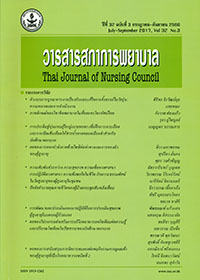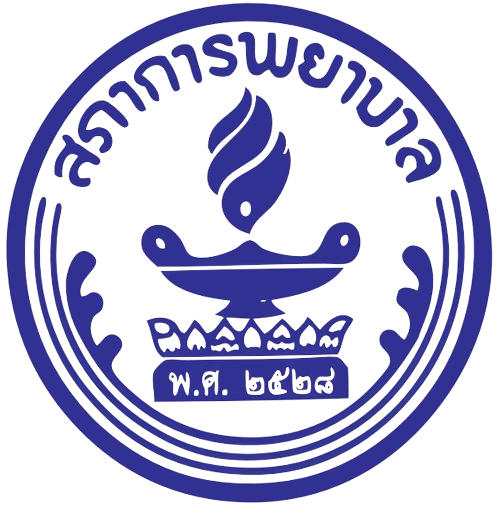ตัวแบบบูรณาการงานป้องกันและแก้ไขการตั้งครรภ์ในวัยรุ่น: ความหมายและการดำเนินงาน
Keywords:
teenage pregnancy, meaning of integrated operation, operation model, mixed-method researchAbstract
Objective: This article presents the fndings of the frst phase of the study conducted as
part of the provincial-level research and evaluation project for the prevention of and solution
to teenage pregnancy. The main objectives of the study were to defne the meaning of ‘integration’
as perceived by the provincial working group and to identify an integrated operation model.
Design: Mixed-method research, concurrent qualitative and descriptive approaches.
Methodology: Qualitative data were collected by means of observation, group discussions,
in-depth interviews and documentary analysis. The respondents, who were selected using
the purposive sampling method combined with word-of-mouth suggestion, their number saturated
at 492, were working-group operators from Chiang Rai, Phayao, Chiang Mai, Lamphun, Lampang,
Tak, Nakhon Sawan, Nakhon Ratchasima, Chaiyaphum, Loei, Maha Sarakham, Khonkaen, Nakhon
Phanom, Chachoengsao, Suphan Buri, Phetcha Buri, Prajuab Khirikhan and Krabi provinces.
The qualitative data were analysed using the thematic analysis method. The descriptive research
part was based on data obtained through structured interviews with 18 project managers. The data
were analysed using the content and thematic analysis methods. Finally, the results of both types
of analysis were integratively discussed.
Results: The term ‘integration’ was defned as entailing open-mindedness, mutual learning
and cooperative efforts, all combined to form a network. The integration models were identifed as
involving 4 styles of operation: (1) a meeting for all, before each team was dispersed with a responsibility;
(2) plan announcement, before each team was dispersed with a task; (3) brainstorming, collating the tasks, assembling the people and pooling money; and (4) brainstorming and operation.
Recommendations: The integration models involving the ‘brainstorming, collating the
tasks, assembling the people and pooling money’ and the ‘brainstorming and operation’ styles
were implemented in a horizontal, rather than vertical, manner. These 2 styles, therefore, enabled
the staff from all sectors to learn from one another, to work together pleasantly and to likely
produce the intended results. It is suggested that nurses be trained to apply these integration
models as a means of enhancing their community- and clinical-level disease prevention and
health promotion performance.
Downloads
References
Washington DC: The Urban Institute Press; 2008.
2. Hodgkinson SC, Colantuoni E, Roberts D, Berg-Cross L, Belcher HME. Depressive symptoms and birth
outcomes among pregnant teenagers. J. Pediatr.
Adol. Gynecol 2010; 23: 16–22.
3. Hall KS, Kusunoki Y, Gatny H, Barber J. The risk
of unintended pregnancy among young women with
mental health symptoms. Soc. Sci. Med 2014;
100: 62–71.
4. United Nations Population Fund Thailand. Motherhood in Childhood. Bangkok: The United Nations
Population Fund Thailand Country Offce and the
Offce of the National Economic and Social Development Board; 2014. (In Thai)
5. Sedgh G, Finer LB, Bankole A, Eilers MA, and Singh S. Adolescent pregnancy, birth, and abortion
rates across countries: Levels and recent trends. J Adolesc Health 2015; 56(2): 223–30. doi:
10.1016/j.jadohealth.2014.09.007.
6. Bureau of Reproductive Health. Fact sheet on statistics on adolescent births, Thailand. Bangkok:
Agricultural Cooperative Printing Demonstrations Thailand; 2016. (In Thai)
7. National of Statistical Offce. population registration/birth/death. Bangkok: National of Statistical
Offce; 2014. (In Thai)
8. Sukrat B. Thailand adolescent birth rate: Trend and related indicators, Thai Journal of Obstetric Gynaecology 2014; 22 (1): 15-21. (In Thai)
9. Bureau of Policy and Strategy, Ministry of Public Health. Information of Delivery Rate for 15-19
year-old per 1,000 persons of 15-19 female population [Cited 7 August 2017] Available from:
URL http://www.http://rh.anamai.moph.go.th/ewt_dl_link.php?nid=86 (In Thai)
10. Bureau of Reproductive Health, Ministry of Public Health. Teenage pregnancy policy, guideline,
monitoring and evaluation. Bangkok: Agricultural Cooperative Printing Demonstrations Thailand;
2014. (In Thai)
11. Ingham R. Teenage pregnancy: some learning from England. Paper presented at National Conference
on Health Sexuality, Bangkok; 8-10 September 2014.
12. Tantivaj S, Pilasun T, Yamapai I, TeerawatananonY, Yotasamut C, Mukdej A et al. Situations of
teenage pregnancy in Thailand 2013. Evaluations of health technology and health project. Bangkok:
Ministry of Public Health; 2013. (In Thai)
13. Mueller T, Tevendale HD, Fuller TR, House LD, Romero LM, Brittain A, Varanasi B. Teen pregnancy prevention: Implementation of a multicomponent, community-wide approach. J Adolesc
Health 2017; 60: S9eS17.
14. UNICEF. (2012). The National Campaign to Prevent Teen Pregnancy: Teen Pregnancy and Education 2010. [Cited 14 August 2012]. Available from: URL http://www.thenationalcampaign.org/why-it-matters/pdf
15. Teenage Pregnancy Independent Advisory Group Final Report. Teenage pregnancy: past success –
future challenges. (2010). [Cited 25 December 2014] Available from: URL http://www.gov.uk/
government/publications/teenage-pregnancypast-successes
16. Chirawatkul S, Anusornteerakul S, Patanasri K, Runreangkulkij S, et al. Report on evaluation of
sexual health promotion programme and projects related to prevention and dealing with problems on
teenage pregnancy; Khon Kaen: Klungnanawittaya;2016. (In Thai)
17. Naksakul K. Knowledge warehouse. Offce of the Royal Society. [Cited 9 February 2015] Available
from: URL http://www.royin.go.th/th/knowledge/detail.php?ID=56 (In Thai)
18. Health Risk Control Plan, Thai Health Promotion Foundation. Guideline for development of prevention
and dealing with teenage pregnancy project based on 9 missions. 2013, Unpublished paper. (In Thai)
19. Creswell JW. Research design: qualitative, quantitative and mixed methods approaches (2nd ed.). Thousand
Oaks, CA: Sage; 2003.
20. Ryan GW, Bernard HR. Techniques to identify themes. Field Methods 2003; 15(1):85–109.
21. Bryman A. Triangulation. In M. Lewis-Beck, A. Bryman, T F. Liao (Eds.). Encyclopedia of social science research methods. Thousand Oaks, CA: Sage; 2004.
22. Tashakkori A, Creswell JW. The new era of mixed methods. Journal of Mixed Methods Research 2007; 1(1): 3-7.
23. Elo S, Kynga SH. The qualitative content analysis process. JAN 2008; 62(1), 107–115 doi: 10. 1111/j.1365-2648.2007.04569.x
24. Demby H, Gregory A, Broussard M, et al. Implementation lessons: the importance of assessing organizational
“ft” and external factors when implementing evidencebased teen pregnancy prevention programs. J Adolesc Health 2014; 54: S37e 44.
25. Kelsey M, Layzer J. Implementing three evidence-based program models: Early lessons from the teen pregnancy
prevention (TPP) replication study. J Adolesc Health 2014; 54: S45e 52.
26. Margolis AL, Roper AY. Practical experience from the Offce of Adolescent Health’s large scale
implementation of an evidence-based teen pregnancy prevention program. J Adolesc Health 2014; 54: S10e4.
27. Wandersman A, Florin P. Community interventions and effective prevention. Am Psychol 2003; 58(6-7): 441-8.
28. Borrill C, West M, Dawson J, Shapiro D, et al. Team working and effectiveness in health care [Cited 12 August 2017] Available from: URL http://homepages.inf.ed.ac.uk/jeanc/DOH-glossy-brochure.pdf
29. Oliver C, Mooney A. Integrated working: a review of the evidence. Children Workforce Development Council 2010 [Cited 12 August 2017] Available from: URL http://dera.ioe.ac.uk/3674/1/Integrated_Working_A_Review_of_the_Evidence_report.pdf
30. Rogers CA. Way of being. Boston: Houghton Mifflin; 1980.
31. Ellis J, Sherwin J, van Dam T. Working in person center ways: A resource book for NSW advocacy and
information services. Sydney: Department of Family and Community Services; 2011.
32. Atkinson M, Jones M. and Lamont E. Multi-agency working and its implications for practice: a review of the literature. Reading: CFBT; 2007.
33. House LD, Tevendale HD, Martinez-Garcia G. Implementing evidence-based teen pregnancyprevention interventions in a community-wide initiative: building capacity and reaching youth. J Adolesc Health 2017; 60:S18e23.
34. Offce of the Public Sector Development Commission. Organization Improvement Toolkits Version 1.0.Bangkok: Amarin Printing & Publishing; 2008.(In Thai)
35. Aalbers R, Dolfsma W, Leenders R. Vertical and horizontal cross-ties: benefts of cross-hierarchy and
cross-unit ties for innovative projects. Paper presented at the DRUID 2011 on Innovation, Strategy and Structure: Organizations, Institutions, Systems and Regions at Copenhagen Business School, Denmark,
June 15-17, 2011.








